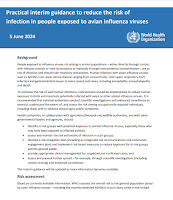#18,270
While the risks of exposure to avian flu are still considered low for most people, as these viruses continue to spread in avian and mammalian species, those risks are expected to rise.
This week the WHO released an interim set of guidance for the public to use to reduce their risk of infection going forward.
People will want to take particular note of the activities listed that may increase the risk of infection, as they go well beyond the usual suspects (i.e. visiting `wet' markets, culling poultry, working with livestock, etc.).
Due to its length, I've only posted some excerpts. Follow the link to read the full document.
Practical interim guidance to reduce the risk of infection in people exposed to avian influenza viruses
28 August 2024| Guidance (normative)
Download (251.1 kB)
Overview
Human infection with avian influenza viruses such as A(H5N1) can cause clinical disease ranging from conjunctivitis, mild upper respiratory tract infection and gastrointestinal issues to more severe outcomes, including encephalitis, encephalopathy and death. To minimize the risk of such human infections, interventions should be implemented to reduce human exposure to birds and mammals potentially infected with avian or other animal influenza viruses. It is recommended that national authorities conduct scientific investigations and enhanced surveillance to monitor, understand the extent of, and assess the risk among occupationally exposed individuals, including those with or without clinical signs and/or symptoms, and provide appropriate clinical management.
This interim guidance will be updated as more information becomes available.
A few excerpts from this 5-page document include:
Risk assessmentBased on currently available information, WHO assesses the overall risk to the general population posed by avian influenza viruses – including the recently detected A(H5N1) virus in dairy cattle in the United States of America – to be low. For those exposed to infected birds or animals or contaminated environments, the risk of infection is considered to be low-to-moderate. (1,2)Activities associated with increased riskWhen influenza viruses are circulating in animals in a given area, people who are exposed to infected or potentially infected animals or their environments through certain activities, including through their work, are at risk of infection – especially those who:
- keep live poultry in their backyards or homes, or who purchase live birds at markets;
- slaughter, de-feather and/or butcher poultry or other animals at home;
- handle and prepare raw poultry for further cooking and consumption;
- have contact with poultry or other animal by-products (such as raw milk, viscera, manure and contaminated/unwashed feathers) or with water contaminated with such by-products (such as wastewater from a live bird market or slaughtering facility);
- consume raw poultry, raw milk or other raw animal meat or by-products;
- engage in outdoor activities (for example, shooting, hunting, animal watching or animal conservation/rescue) that may involve exposure to wild animals;
- work in the poultry or other livestock industry or fur farms or zoos (including farmers and veterinarians), or who visit animal farms or premises in the course of their work (such as animal and public health responders), or who transport or sell live poultry or other animals or carcasses or slaughter animals, or who are involved in culling/depopulating/disposing of poultry or other animals or in the decontamination of contaminated premises
Recommendations
1. Minimize exposure
General public and those whose activities may put them at increased risk of infectionGiven the observed extent and frequency of avian influenza in poultry, wild birds and some wild and domestic mammals, the public are recommended to:
- avoid contact with animals that are sick or dead from unknown causes, including wild animals;
- report sick or unexpectedly dead animals to their veterinarian or local authorities;
- follow good food safety and personal hygiene practices (especially hand washing);
- properly handle and cook eggs, poultry meat and other animal products;
- only slaughter healthy animals for human consumption – animals that have unexpectedly died should not be consumed and should be disposed of appropriately in accordance with national regulations;
- avoid consuming raw/unpasteurized milk;
- seek health care if feeling unwell and inform their health care provider of any possible exposure to sick animals; and
- comply with all other national or local official measures put in place (for example, animal movement restrictions).
People who have direct or indirect contact with infected or potentially infected animals or theirenvironments through the course of their work that puts them at increased risk of infection
People at risk of exposure to infected or potentially infected animals through the course of their work should wear appropriate personal protective equipment (PPE). PPE must be correctly fitted, used and removed, and safely disposed of or decontaminated. Individuals needing to use PPE should be provided with it and trained in its appropriate use. PPE may include the following depending on the risk assessment specific to the work involved:
- fluid-resistant coveralls
- particulate respirators (single-use FFP2, N95 equivalent or higher quality)
- eye protection (googles or face shield)
- gloves (heavy duty gloves depending on the task)
- boots.
People whose work includes activities that may put them at increased risk of exposure to potentially infected animals (such as selling live animals, or slaughtering and processing animals) should ideally wear light-coloured and clean protective clothing, aprons, gloves and rubber boots to ensure that any soiling is obvious. Eye protection should also be considered whenever possible, and good food safety and hygiene practices followed (especially hand washing).(SNIP)
In addition to frequent environmental cleaning and disinfection, individuals in at-risk groups should perform hand hygiene, either with alcohol-based hand rub or by washing their hands with soap and water if visibly soiled. This should be done regularly – but especially before and after contact with animals and their environments. Efforts should be made to avoid touching the nose, eyes or mouth with the hands during work. Showering and changing into clean clothes after work, if feasible, is also recommended.
While I hesitate to call this the `new normal', it is unfortunately our new reality.
